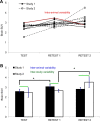Impact of inherent variability and experimental parameters on the reliability of small animal PET data
- PMID: 22682020
- PMCID: PMC3438085
- DOI: 10.1186/2191-219X-2-26
Impact of inherent variability and experimental parameters on the reliability of small animal PET data
Abstract
Background: Noninvasive preclinical imaging methodologies such as small animal positron emission tomography (PET) allow the repeated measurement of the same subject which is generally assumed to reduce the variability of the experimental outcome parameter and to produce more robust results. In this study, the variability of tracer uptake in the rodent brain was assessed within and between subjects using the established radiopharmaceuticals 18F-FDG and 18F-fallypride. Moreover, experimental factors with potential impact on study outcome were elicited, and the effect of their strict homogenization was assessed.
Methods: Brain standardized uptake values of rodents were compared between three PET scans of the same animal and scans of different individuals. 18F-FDG ex vivo tissue sampling was performed under variation of the following experimental parameters: gender, age, cage occupancy, anesthetic protocol, environmental temperature during uptake phase, and tracer formulation.
Results: No significant difference of variability in 18F-FDG or 18F-fallypride brain or striatal uptake was identified between scans of the same and scans of different animals (COV = 14 ± 7% vs. 21 ± 10% for 18F-FDG). 18F-FDG brain uptake was robust regarding a variety of experimental parameters; only anesthetic protocols showed a significant impact. In contrast to a heterogenization approach, homogenization of groups produced more false positive effects in 18F-FDG organ distribution showing a false positive rate of 9% vs. 6%.
Conclusions: Repeated measurements of the same animal may not reduce data variability compared with measurements on different animals. Controlled heterogenization of test groups with regard to experimental parameters is advisable as it decreases the generation of false positive results and thus increases external validity of study outcome.
Figures



Similar articles
-
Comparative test-retest variability of outcome parameters derived from brain [18F]FDG PET studies in non-human primates.PLoS One. 2020 Oct 5;15(10):e0240228. doi: 10.1371/journal.pone.0240228. eCollection 2020. PLoS One. 2020. PMID: 33017429 Free PMC article.
-
Positron Emission Tomography (PET) and Pharmacokinetics: Classical Blood Sampling Versus Image-Derived Analysis of [18F]FAZA and [18F]FDG in a Murine Tumor Bearing Model.J Pharm Pharm Sci. 2018;21(1s):32s-47s. doi: 10.18433/jpps29788. J Pharm Pharm Sci. 2018. PMID: 29702045
-
Multicenter Clinical Trials Using 18F-FDG PET to Measure Early Response to Oncologic Therapy: Effects of Injection-to-Acquisition Time Variability on Required Sample Size.J Nucl Med. 2016 Feb;57(2):226-30. doi: 10.2967/jnumed.115.162289. Epub 2015 Oct 22. J Nucl Med. 2016. PMID: 26493206 Free PMC article.
-
Variability and uncertainty of 18F-FDG PET imaging protocols for assessing inflammation in atherosclerosis: suggestions for improvement.J Nucl Med. 2015 Apr;56(4):552-9. doi: 10.2967/jnumed.114.142596. Epub 2015 Feb 26. J Nucl Med. 2015. PMID: 25722452 Review.
-
Detection of distant interval metastases after neoadjuvant therapy for esophageal cancer with 18F-FDG PET(/CT): a systematic review and meta-analysis.Dis Esophagus. 2018 Dec 1;31(12). doi: 10.1093/dote/doy055. Dis Esophagus. 2018. PMID: 29917073
Cited by
-
Imaging dopaminergic dysfunction as a surrogate marker of neuropathology in a small-animal model of HIV.Mol Imaging. 2014;13:10.2310/7290.2014.00031. doi: 10.2310/7290.2014.00031. Mol Imaging. 2014. PMID: 25248756 Free PMC article.
-
PET∕CT imaging evidence of FUS-mediated (18)F-FDG uptake changes in rat brain.Med Phys. 2013 Mar;40(3):033501. doi: 10.1118/1.4789916. Med Phys. 2013. PMID: 23464343 Free PMC article.
-
The Effects of Physiological and Methodological Determinants on 18F-FDG Mouse Brain Imaging Exemplified in a Double Transgenic Alzheimer Model.Mol Imaging. 2016 Feb 11;15:1536012115624919. doi: 10.1177/1536012115624919. Print 2016. Mol Imaging. 2016. PMID: 27030402 Free PMC article.
-
Assessment of the Effects of 6 Standard Rodent Diets on Binge-Like and Voluntary Ethanol Consumption in Male C57BL/6J Mice.Alcohol Clin Exp Res. 2015 Aug;39(8):1406-16. doi: 10.1111/acer.12773. Epub 2015 Jun 25. Alcohol Clin Exp Res. 2015. PMID: 26110576 Free PMC article.
-
FDG-PET imaging in mild traumatic brain injury: a critical review.Front Neuroenergetics. 2014 Jan 9;5:13. doi: 10.3389/fnene.2013.00013. Front Neuroenergetics. 2014. PMID: 24409143 Free PMC article. Review.
References
-
- Cherry SR. Of mice and men (and positrons) – advances in PET imaging technology. J Nucl Med. 2006;47:1735–1745. - PubMed
-
- Cherry SR, Gambhir SS. Use of positron emission tomography in animal research. ILAR J. 2001;42:219–232. - PubMed
-
- Van Zutphen LFM, Baumans V, Beynen AC. Grundlagen der Versuchstierkunde. Gustav Fischer Verlag, Stuttgart; 1995.
LinkOut - more resources
Full Text Sources

